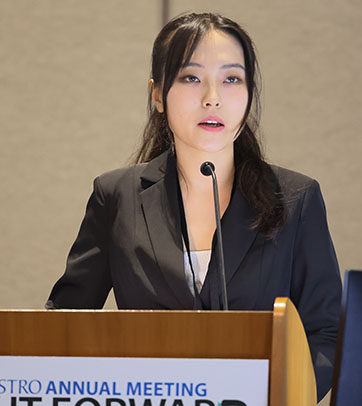


By Narek Shaverdian, MD, Memorial Sloan Kettering Cancer Center
For patients with extensive-stage small cell lung cancer (ES-SCLC), earlier trials by Slotman et al., and Jeremic et al., established the role of consolidative thoracic radiation (cTRT) in patients who show response to initial systemic therapy. In these prior two trials, doses of 30 Gy in 10 fractions and 54 Gy in 36 fractions, respectively, were used and were associated with an improvement in overall survival. Current NCCN guidelines include the consideration of cTRT in patients with a response to initial systemic therapy with the dosing and fractionation recommended to be individualized within the range of 30 Gy in 10 fractions up to definitive dosing. This study by Bi et al., “30 Gy vs. 45 Gy Consolidative Thoracic Radiation (cTRT) for Extensive Stage Small Cell Lung Cancer (ES-SCLC): A Multicenter, Randomized, Phase 3 Trial” presented at ASTRO sought to better define the optimal dose for cTRT. Given recent trials showing a survival benefit of radiation dose escalation in patients with limited-stage small cell lung cancer, one could potentially see this benefit to translate to patients with ES-SCLC.
In these phase III trials, patients were to receive etoposide plus platinum chemotherapy and were randomized to receive either 30 Gy in 10 fractions or 45 Gy in 15 fractions, with the primary endpoint being improvement in two-year overall survival. Over the course of six years, 90 patients were randomized with the slow accrual and the subsequent approval of immunotherapy in the first line setting for ES-SCLC leading to early trial closure. Despite the early closure, with a median follow-up of nearly 40 months, there was no significant difference in two-year OS between the 45 Gy and 30 Gy group (43% vs 40%, respectively, p=0.62) with no differences additionally in local-regional control (p=0.75). However, there was an increased incidence of grade 3+ radiation pneumonitis (10% vs 2%) and hematological toxicity (20% vs 12.5%) in patients treated with the higher 45Gy dose.
While this study is limited by its early closure, the results are important and can help guide practice. Although the frontline therapy for ES-SCLC now includes chemoimmunotherapy, the lack of a clear survival benefit or improvement in local-regional control suggests that 30 Gy in 10 fractions may be sufficient for the purposes of cTRT among unselected patients. Additionally, the increase in both pulmonary and hematologic toxicity with the higher cTRT dose should give even greater pause with chemoimmunotherapy given the concerns of pneumonitis and lymphopenia in the context of immunotherapy. This is particularly important as the trials evaluating frontline chemoimmunotherapy for ES-SCLC did not even permit thoracic radiation. While randomized studies investing cTRT in the context of chemoimmunotherapy are needed for definitive evidence, the trial by Bi et al., suggests that offering 30 Gy in 10 fractions may be striking just the right balance.
Abstract 208 - 30 Gy vs. 45 Gy Consolidative Thoracic Radiation (cTRT) for Extensive Stage Small Cell Lung Cancer (ES-SCLC): A Multicenter, Randomized, Phase 3 Trial was presented on October 3, 2023, during the SS 19: Lung 3: Clinical Trials for Small Cell and Oligometastatic Lung Cancer session at the 2023 ASTRO Annual Meeting.